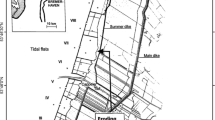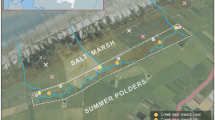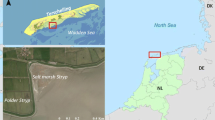Abstract
A storm-surge barrier was constructed in the mouth of the Oosterschelde, a euhaline mesotidal estuary in the SW Netherlands (mean tidal range 3.6 m). As a consequence, the tidal range and the Mean High Water in the estuary have been reduced to about 88% of their original values.
During the final construction stage of this barrier (1986–87) both were reduced to a maximum of 65% for more than 18 months. During this period, large-scale die-back of the vegetation occurred in vast areas on the salt marshes; locally, a complete die-back of the vegetation took place. Glycophytes and disturbance indicating species appeared on a large scale and grew abundantly. After the new tidal regime had been established, the vegetation recovered. The species characteristic of disturbance, are gradually being replaced by perennial salt marsh species. In addition, most species are shifting into zones of lower elevation, which correspond (in 1990/1991) more or less with the original flooding frequencies. Moreover, in many basins the ‘levee’-species Halimione portulacoides and Elymus pycnanthus are far more prominent than before, probably as a result of the strong ripening of the soil that has occurred in these basins during the extra tidal reduction. In 1991, four years after the establishment of the new tidal regime, the salt marsh vegetation had still not been stabilized.
Similar content being viewed by others
References
Adam, P., 1990. Saltmarsh ecology. Cambridge University Press, Cambridge.
Beeftink, W. G., 1965. De zoutvegetatie van ZW Nederland beschouwd in europees verband (Salt marsh communities of the SW Netherlands in relation to the European halophytic vegetation; in Dutch). Ph. D. Thesis. Mededelingen Landbouwhogeschool 65–1, Wageningen, 167 pp.
Beeftink, W. G., 1975. The ecological significance of embankment and drainage with respect to the vegetation of the South-West Netherlands. J. Ecol., 63: 423–458.
Beeftink, W. G., 1977a. Salt-marshes. In: R. S. K. Barnes (ed.), The Coastline, Chapter 6, John Wiley & Sons, London: 93–121.
Beeftink, W. G., 1977b. The coastal salt marshes of Western and Northern Europe: An ecological and phytosociological approach. In V. J. Chapman (ed.), Wet coastal ecosystems, Elsevier, Amsterdam: 109–155.
Beeftink, W. G., 1979. The structure of salt marsh communities in relation to environmental disturbances. In: R. L. Jefferies & A. J. Davy (eds), Ecological processes in coastal environments. Blackwell, Oxford: 77–93.
Beeftink, W. G., 1987. Vegetation responses to changes in tidal inundation of salt marhes. In: J. van Andel, J. P. Bakker & R. W. Snaydon (eds), Disturbance in grasslands. Junk publishers, Dordrecht: 77–117.
Beeftink, W. G., W. de Munck & J. Nieuwenhuize, 1978. Aspects of population dynamics in Halimione portulacoides communities. Vegetatio 36: 31–43.
Chapman, V. J., 1977. Introduction. In: V. J. Chapman (ed.), Wet Coastal Ecosystems. Elsevier, Amsterdam: 1–29.
De Jong, D. J. & T. J. de Kogel, 1979. Vegetatieontwikkeling op de Slikken van Flakkee van 1972 tot en met 1978 (Vegetation development at the Slikken van Flakkee from 1972–1978; in Dutch). Rijkswaterstaat, Middelburg (NL) report 79–11.
De Jong, D. J. & T. J. de Kogel, 1985. Salt-marsh research with respect to the civil-engineering project in the Oosterschelde, The Netherlands. Vegetatio 62: 425–432.
De Jong, D. J. & Z. de Jong, 1994. The consequences of a one-year tidal reduction of 35% for salt marshes in the Oosterschelde (SW Netherlands). In Jones, N. V. & J. S. Pethick (eds), The Changing Coastline. Coastal Zone Topics: Process, Ecology and Management, Vol. I. Joint Nature Conservation Council, in press.
De Jong, D. J., Z. de Jong & J. P. M. Mulder, 1994. Changes in area, geomorphology and sediment nature of salt marshes in the Oosterschelde estuary (SW Netherlands) due to tidal changes. Hydrobiologia 282/283: 303–316.
De Kogel, T. J. & D. J. de Jong, 1980. Vegetatiekartering van de schorren in de Oosterschelde en het Krammer-Volkerak, 1978 (Vegetation mapping of the salt marshes in the Oosterschelde and Krammer-Volkerak, 1978; in Dutch). Rijkswaterstaat, Middelburg (NL). Nota DDMI 80.20.
De Leeuw, J., L. Apon, P. M. J. Herman, W. de Munck & W. G. Beeftink, 1992. Vegetation response to experimental and natural disturbance in two saltmarsh plant communities in the SW Netherlands. Neth. J. of Sea Res. 30: 279–288.
De Leeuw, J., L. Apon, P. Herman, W. de Munck & W. G. Beeftink, 1994. The response of salt-marsh vegetation to tidal reduction caused by the Oosterschelde storm-surge barrier. Hydrobiologia 282/283: 335–353.
Groenendijk, A. M., 1987. Ecological consequences of a storm-surge barrier in the Oosterschelde: the salt marshes. Ph. D. Thesis, State University Utrecht/Delta Inst. f. Hydrob. Res. Comm. Nr. 359, 177 pp.
Long, S. P. & C. F. Mason, 1983. Saltmarsh ecology. Blackie, Glasgow, 160 pp.
Nienhuis, P. H. & A. C. Smaal, 1994. The Oosterschelde estuary, a case study of a changing ecosystem: an introduction. Hydrobiologia 282/283: 1–14.
Oenema, O., 1988. Pyrite accumulation in salt marshes in the Eastern Scheldt. In: Oenema, O., 1988: Early diagenesis in recent fine-grained sediments in the Eastern Scheldt. State University Utrecht, Institute of Earth Sciences, Ph. D. Thesis, 222 pp.
Saeijs, H. L. F. & J. P. Al, 1982. Environmental impact assessment for design and management of the Oosterschelde Barrier. In: Saeijs, H. L. F., 1982: Changing estuaries. Rijkswaterstaat Communications nr 32; Min of Transport and Public Works, The Hague, The Netherlands: 279–320.
Smies, M. & A. H. L. Huiskes, 1981. Holland's Eastern Scheldt Estuary Barrier Scheme: Some ecological considerations. Ambio 10: 158–165.
Tutin, T. G., V. H. Heywood, N. A. Burgess, D. M. Moore, D. H Valentine, S. M. Walters & D. A. Webb, 1964–1980. Flora Europaea. Cambridge University Press, Cambridge, 5 Volumes.
Van Diggelen, J., 1988. A comparative study on the ecophysiology of salt marsh halophytes. Ph. D. Thesis, Free University Press, Amsterdam, 208 pp.
Vranken, M., O. Oenema & J. P. M. Mulder, 1990. Effects of tide range alterations on salt marsh sediments in the Eastern Scheldt, SW Netherlands. Hydrobiologia 195: 13–20.
Vroon, J., 1994. Hydrodynamic characteristics of the Oosterschelde in recent decades. Hydrobiologia 282/283: 17–27.
Author information
Authors and Affiliations
Rights and permissions
About this article
Cite this article
de Jong, D.J., van der Pluijm, A.M. Consequences of a tidal reduction for the salt-marsh vegetation in the Oosterschelde estuary (The Netherlands). Hydrobiologia 282, 317–333 (1994). https://doi.org/10.1007/BF00024639
Issue Date:
DOI: https://doi.org/10.1007/BF00024639




